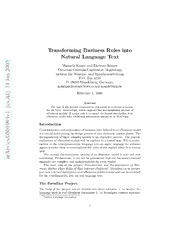
Transforming Business Rules Into Natural Language Text PDF
Preview Transforming Business Rules Into Natural Language Text
Transforming Business Rules into Natural Language Text 5 0 Manuela Kunze and Dietmar R¨osner 0 2 Otto-von-Guericke-Universit¨at Magdeburg Institut fu¨r Wissens- und Sprachverarbeitung n a P.O. Box 4120 J D–39016 Magdeburg, Germany, 1 3 makunze|[email protected] ] February 1, 2008 I A . s Abstract c [ The aim of the project presented in this paper is to design a system for an NLG1 architecture, which supports the documentation process of 1 eBusiness models. A major task is to enrich the formal description of an v eBusiness model with additional information needed in an NLG task. 3 9 0 Introduction 1 0 CommunicationandexplanationofbusinessrulesdefinedinaneBusinessmodel 5 isacrucialpointduringthedesignprocessofnewelectronicmarketplaces. The 0 documentation of these complex models is an expensive process. The concep- / s tualization of eBusiness models will be realized in a formal way. The transfor- c mation of the conceptualization language into an agent language for software : v agents is easier than to communicate the rules of the market place to a human i X user. The manual documentation process of an eBusiness model is time and cost r a consuming. Furthermore, it can not be guaranteedthat the documents created manually are complete and understandable for every reader. The main task of the project ‘Formalization and Documentation of Elec- tronic Market Place Rules of Real Internet Platforms’ (FormDoc) is to investi- gatehowaformaldescriptionofaneBusinessplatformmustandcanbeenriched for the transformation into natural language text. The FormDoc Project The tasks of the project can be divided into three subtasks: i. to analyse the language used in real eBusiness documents ii. to investigate current represen- 1NaturalLanguage Generation 1 tations formats for business rules (e.g. CLP [GLC99]), and iii. to specify the requirements for an NLG architecture for the documentation task. Crucial questions of the first two subtasks are: • In which ways can formal concepts be expressed by natural language terms? • Which rules and concepts can be summarized? Which linguistic means can be used for aggregationof rules? • Which concepts and rules must be verbalized in the documents? Itisnecessarytocarryoutexperimentswithdifferentlanguages(inourcase GermanandEnglish),becauseeBusinessmarketplacesareavailableinWWW. One initial pointfor the last subtaskis to test the KPML environment[Bat95]. KPML contains different language resources,which can be easily extended and adapted for our requirements. But the crucial question is: Is the necessary linguistic competence available in the front end generator KPML? In the project outline above, a main task is the design of an appropriate semantic representation for business rules. The semantic representation should be useable for • implementing the market place, • simulating the market place, and • generatingnaturallanguagedocumentationaboutthe rulesofthe market place. For the generation process, it is necessary to augment the rules within an eBusiness model with linguistic information (like canned phrases, linguis- tic terms, synonyms, etc.). Another main focus for the generation process is to group or to summarize the rules, because in order to avoid repetition and verbosity,the ruleswithinamodelshouldbe groupedintoclustersofrulesthat describe a similar content. For example, following rules are given: <steadySpender> if shopper(?Cust) and spendingHistory(?Cust, loyal) then giveDiscount(percent5, ?Cust); <platinumClub> if shopper(?Cust) and memberPlatinumClub(?Cust) then giveDiscount(percent10, ?Cust); These two rules can be expressed with the following single sentence: Cus- tomers with a loyal spending history obtain a discount of 5 % but as member of a platinum card you obtain a discount of 10 %. Another kind of summarizing can be realized for the next example: 2 <steadySpender> if shopper(?Cust) and spendingHistory(?Cust, loyal) then giveDiscount(percent5, ?Cust); <storeCard> if shopper(?Cust) and hasChargeCard(?Cust, store) then giveDiscount(percent5, ?Cust); In this case, the same implication is given but different premises are de- scribed. These rules can be summarized through the following sentence: Cus- tomers with a loyal spending history or members of our charge card obtain a discount of 5 %. The work of the project started with a feasibility study using KPML as NLG environment and first analyses of the characteristics of the sublanguage used in real eBusiness documents. Currently, the project work is concentrated on the description of a (meta data) model for the interpretation and selection of business rules. This model should be used to bridge the gap between a formalsemanticrepresentationandnaturallanguagetext. Themodeldescribes which additional information or knowledge about rules in an eBusiness model is necessary for the NLG process. References [Bat95] J. A. Bateman. KPML:The KOMET-PenmanMultilingual Resource Development Environment. In Proceedings of the Fifth European Workshop on Natural Language Generation, pages 219–222, Leiden, The Netherlands, May 1995. Faculty of Social and Behavioural Sci- ences, University of Leiden. [GLC99] Benjamin N.Grosof,Yannis Labrou,andHoiY. Chan. ADeclarative Approach to Business Rules in Contracts: Courteous Logic Programs in XML. In Proceedings of the First ACM Conference on Electronic Commerce (EC-99). Denver, CO, 1999. 3
